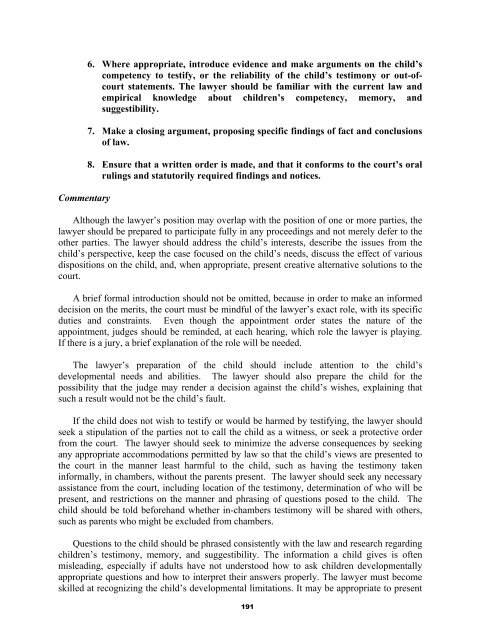A Judge’s Guide
A Judge’s Guide
A Judge’s Guide
Create successful ePaper yourself
Turn your PDF publications into a flip-book with our unique Google optimized e-Paper software.
Commentary<br />
6. Where appropriate, introduce evidence and make arguments on the child’s<br />
competency to testify, or the reliability of the child’s testimony or out-ofcourt<br />
statements. The lawyer should be familiar with the current law and<br />
empirical knowledge about children’s competency, memory, and<br />
suggestibility.<br />
7. Make a closing argument, proposing specific findings of fact and conclusions<br />
of law.<br />
8. Ensure that a written order is made, and that it conforms to the court’s oral<br />
rulings and statutorily required findings and notices.<br />
Although the lawyer’s position may overlap with the position of one or more parties, the<br />
lawyer should be prepared to participate fully in any proceedings and not merely defer to the<br />
other parties. The lawyer should address the child’s interests, describe the issues from the<br />
child’s perspective, keep the case focused on the child’s needs, discuss the effect of various<br />
dispositions on the child, and, when appropriate, present creative alternative solutions to the<br />
court.<br />
A brief formal introduction should not be omitted, because in order to make an informed<br />
decision on the merits, the court must be mindful of the lawyer’s exact role, with its specific<br />
duties and constraints. Even though the appointment order states the nature of the<br />
appointment, judges should be reminded, at each hearing, which role the lawyer is playing.<br />
If there is a jury, a brief explanation of the role will be needed.<br />
The lawyer’s preparation of the child should include attention to the child’s<br />
developmental needs and abilities. The lawyer should also prepare the child for the<br />
possibility that the judge may render a decision against the child’s wishes, explaining that<br />
such a result would not be the child’s fault.<br />
If the child does not wish to testify or would be harmed by testifying, the lawyer should<br />
seek a stipulation of the parties not to call the child as a witness, or seek a protective order<br />
from the court. The lawyer should seek to minimize the adverse consequences by seeking<br />
any appropriate accommodations permitted by law so that the child’s views are presented to<br />
the court in the manner least harmful to the child, such as having the testimony taken<br />
informally, in chambers, without the parents present. The lawyer should seek any necessary<br />
assistance from the court, including location of the testimony, determination of who will be<br />
present, and restrictions on the manner and phrasing of questions posed to the child. The<br />
child should be told beforehand whether in-chambers testimony will be shared with others,<br />
such as parents who might be excluded from chambers.<br />
Questions to the child should be phrased consistently with the law and research regarding<br />
children’s testimony, memory, and suggestibility. The information a child gives is often<br />
misleading, especially if adults have not understood how to ask children developmentally<br />
appropriate questions and how to interpret their answers properly. The lawyer must become<br />
skilled at recognizing the child’s developmental limitations. It may be appropriate to present<br />
191


